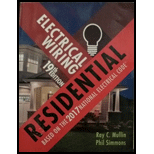
ELECTRICAL WIRING:RESIDENT.-TEXT (PB)
19th Edition
ISBN: 9781337116213
Author: MULLIN
Publisher: CENGAGE L
expand_more
expand_more
format_list_bulleted
Concept explainers
Question
Chapter 2.1, Problem 17R
a.
To determine
Explain the uses of junction boxes.
b.
To determine
Explain whether all the junction boxes are normally used in first floor or not.
c.
To determine
Explain whether the junction boxes are normally used to wire exposed portion of the basement or not.
Expert Solution & Answer
Trending nowThis is a popular solution!

Students have asked these similar questions
Q3/A unity-feedback system with the forward transfer function
G(S)=
K
S(S+7)
is operating with a closed-loop step response that has 15% overshoot. Do the following:
a. Evaluate the steady-state error for a unit ramp input.
b. Design a lag compensator to improve the steady-state error by a factor of 20 to get a
new dominant closed-loop poles S-3.4+ j5.63. place the pole of the lag compensator
at s=-0.01
c. Design a lag compensator using OP amp if R1= 100KS2 R2=10 KS2 and R3= 10K
please explain and draw the graphs clearly, I am most confused with the graphs thanks
please show step by step and explain clearly
Chapter 2 Solutions
ELECTRICAL WIRING:RESIDENT.-TEXT (PB)
Ch. 2.1 - What is the purpose of specifications?Ch. 2.1 - Refer to the specifications in the back of this...Ch. 2.1 - What is done to prevent a plan from becoming...Ch. 2.1 - Name three requirements contained in the...Ch. 2.1 - Prob. 5RCh. 2.1 - What phrase is used when a substitution is...Ch. 2.1 - What is the purpose of an electrical symbol?...Ch. 2.1 - Prob. 8RCh. 2.1 - Prob. 9RCh. 2.1 - What three parties must be satisfied with the...
Ch. 2.1 - What does a plan show about electrical outlets?...Ch. 2.1 - Prob. 13RCh. 2.1 - Prob. 14RCh. 2.1 - Prob. 15RCh. 2.1 - Prob. 16RCh. 2.1 - Prob. 17RCh. 2.1 - Prob. 18RCh. 2.1 - Prob. 19RCh. 2.1 - What methods may be used to mount luminaries to an...Ch. 2.1 - What advantage does a 4 in. octagon box have over...Ch. 2.1 - What is the size of the opening of a switch...Ch. 2.1 - Prob. 23RCh. 2.1 - Prob. 24RCh. 2.1 - Prob. 25RCh. 2.1 - Prob. 26RCh. 2.1 - Prob. 27RCh. 2.1 - Prob. 28RCh. 2.1 - Prob. 29RCh. 2.1 - Prob. 30RCh. 2.1 - Prob. 31RCh. 2.1 - Prob. 32RCh. 2.1 - Prob. 33RCh. 2.1 - Prob. 35RCh. 2.1 - Prob. 37RCh. 2.1 - Prob. 38RCh. 2.1 - Prob. 39RCh. 2.1 - Prob. 40RCh. 2.1 - Prob. 42RCh. 2.1 - Does the NEC allow metal raceways to be used with...Ch. 2.2 - Prob. 1RCh. 2.2 - What is the size of the footing for the steel...Ch. 2.2 - Prob. 3RCh. 2.2 - Prob. 4RCh. 2.2 - Prob. 5RCh. 2.2 - Prob. 6RCh. 2.2 - How far is the front garage wall from the curb?...Ch. 2.2 - How far is the side garage wall from the property...Ch. 2.2 - Prob. 9RCh. 2.2 - What is the purpose of the I-beams that rest on...Ch. 2.2 - Where is access to the attic provided?...Ch. 2.2 - Prob. 13RCh. 2.2 - Prob. 14RCh. 2.2 - Prob. 15RCh. 2.2 - Prob. 16RCh. 2.2 - What is the stud size for the partitions between...Ch. 2.2 - Who is to furnish the range hood?...Ch. 2.2 - Who is to install the range hood?...
Knowledge Booster
Learn more about
Need a deep-dive on the concept behind this application? Look no further. Learn more about this topic, electrical-engineering and related others by exploring similar questions and additional content below.Similar questions
- Please solve this question step by step handwritten solution and do not use ai or chat gpt please thank youarrow_forwardFind the mathematical expression in fourier series for this output below shown in the image. This must have the terms ao, ak and bkarrow_forwardPlease solve this question step by step handwritten solution and do not use ai or chat gpt please thank youarrow_forward
- Please solve this question step by step hand written solution and do not use ai or chat gpt thank youarrow_forwardPlease solve this question handwritten, step by step showing details and no ai or chat gpt solution please thank youarrow_forwardPlease explain each quations, I'll give positive feedback. For the graphs, please draw what it looks likearrow_forward
- please explain all steps and draw any drawings, don't just explain what they look like please. thank youarrow_forwardplease explain and show all steps, thank you.arrow_forwardA rectangular waveguide with dimensions a = 2.5 cm, b = 1 cm is to operate at 15 GHz. σ = 0, E4, μ= 1 3- Calculate phase constant for TE10 mode. 4- Calculate the phase velocity and wave impedance for the same mode.arrow_forward
- Find v(t) for t> 0 in the circuit of Fig. below. Assume the switch has been open for a long time and is closed at t = 0. Calculate v (t) at t = 0.5. 10 V 202 www +21 t=0 60 ww 13 F بلا SVarrow_forwardQ: A rectangular waveguide with dimensions a = 2.5 cm, b = 1 cm is to operate at 15 GHz. σ = 0, E4, μ = 1 1- At which frequencies this type of TL (transmission line) operate ? 2- Why this this type is used in such frequencies? 3- Calculate phase constant for TE10 mode. 4- Calculate the phase velocity and wave impedance for the same mode.arrow_forwardK Q1/ For the system G(s)= (s+2)(s+4)(s+5) H(s)=1 a. Draw the Bode log-magnitude and phase plots. b. Find the range of K for stability from your Bode plots. c. Evaluate gain margin, phase margin, zero dB frequency, and 180° frequency from your Bode plots for K = 200arrow_forward
arrow_back_ios
SEE MORE QUESTIONS
arrow_forward_ios
Recommended textbooks for you
 EBK ELECTRICAL WIRING RESIDENTIALElectrical EngineeringISBN:9781337516549Author:SimmonsPublisher:CENGAGE LEARNING - CONSIGNMENT
EBK ELECTRICAL WIRING RESIDENTIALElectrical EngineeringISBN:9781337516549Author:SimmonsPublisher:CENGAGE LEARNING - CONSIGNMENT

EBK ELECTRICAL WIRING RESIDENTIAL
Electrical Engineering
ISBN:9781337516549
Author:Simmons
Publisher:CENGAGE LEARNING - CONSIGNMENT
Latches and Flip-Flops 1 - The SR Latch; Author: Computer Science;https://www.youtube.com/watch?v=-aQH0ybMd3U;License: Standard Youtube License